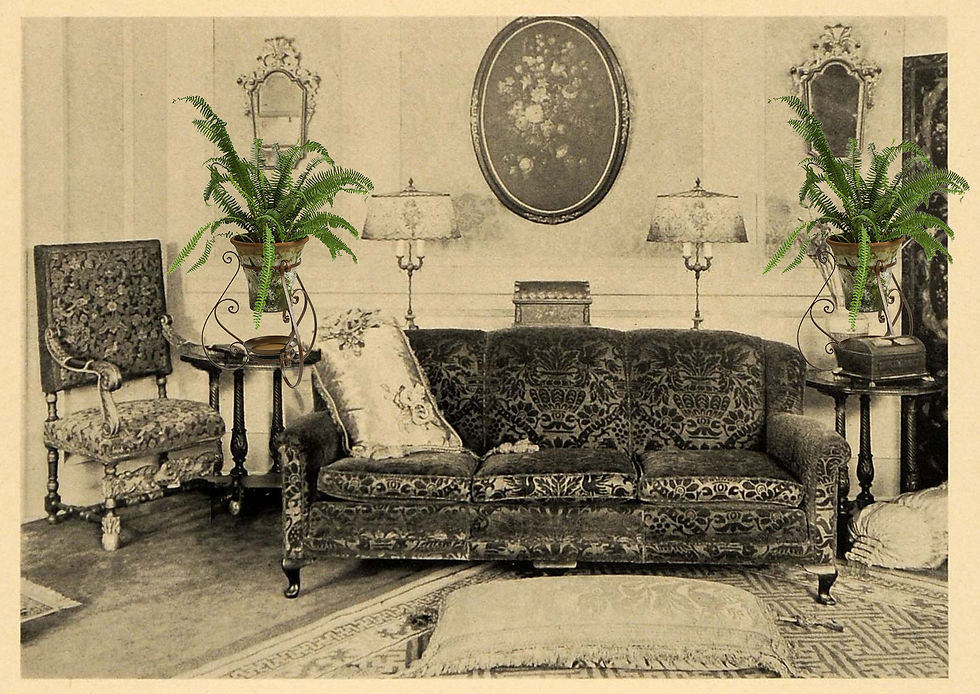Plant Trends Throughout the Decades (1920-2020)
- Flora
- Jul 21
- 4 min read


1920's Plant Trends

Low light plants became very popular, but the most popular plant was not a low light plant at all. In fact, Ferns became all the rage and people often used pedestals to adorn and celebrate these beutiful plants.
In the outdoors, things like Roses, Boxwood and Foxgloves were seen alongside perennial flowering plants.


1930's Plant Trends

As glazed planters started to became more popular and available to the public, people started to bring plants indoors. Dracaenas, Ivy, and Fiddle Leaf Fig plants started to make their way into people's homes and furniture started to move closer to windows for those light loving plants.
In the outdoors, things like Enlgish Ivy, Screwpines, and Grape Ivy's were also very popular.


1940's Plant Trends

As wartime became prevalent, people started to save more and purchase smaller homes. Plants played a huge role in making those homes feel spacious as people used them to separate and define spaces in their homes. Plants such as Snake plants and dish gardens became very popular in homes.
Additionally, as women entered the work force, office plants became more popular. In order to brighten up the place, plants such as African Violets and Pothos became increasingly popular.
In the outdoors, people started to grow more vegetables in their gardens as well as adding ornamental plants like Rhododendrons, Hydrangeas and Junipers.


1950's Plant Trends

Maximalism was in, and with that, large plants became the new trend to have in your home. Plants such as Parlor Palms, Philodendrons, Bird of Paradise, and Fiddle Leaf Figs were essential. People also started collecting plants; unique flowering plants like African Violets and Begonias were collectors' must-haves.
In the outdoors, the trends of flowering perennials stayed strong with the addition of different shrubs like Booxwood and Holly plants.


1960's Plant Trends

As fluorescent lighting became more popular, so did collecting plants. Having an indoor garden, rare plants, and even light-loving plants was finally a possibility. With this, large plants started to shrink, and Eyelash Begonias and Orchids were a collector's dream.
Plants also became more readily available, and plants like Golden Pothos, Snake Plants, and African Violets stayed popular. While those plants were on the rise, plants like Swiss Cheese Monsteras and Split Leaf Philodendrons were a rare find.
In the outdoors, bright and colorful plants like Dahlias, Geraniums, Daylilies, and Gladioli were very popular.


1970's Plant Trends

With the rise of macramé crafts, hanging plants became the new trend. Hanging and trailing plants such as Spider Plants and Hoyas became very popular. Christmas Cactus and Ferns also became a must-have.
In the outdoors, Yucca plants and Rubber plants became popular due to their beautiful flowers (Yucca Plant) and bright colors (Rubber Plant). Low maintenance plants like Ivies stayed on trend.


1980's Plant Trends

With trends like sliding doors and atrium windows, bringing in more light-loving plants became very popular. Plants like Anthuriums, Bird of Paradise, and Flowering Ginger were very popular; the bigger or more dramatic the plant, the better.
Atrium trends were so big that they made their way to the mall, bringing indoor plants to most malls in the USA.
In the outdoors, low-maintenance shrubs like Berberis, Mahonia, and Phormiums were imperative.



1990's Plant Trends
Due to nostalgia, trends like hanging and trailing plants stayed popular. As Hoyas and Ivys were still on trend, a new plant came on the rise. The Ficus Benjamina became a must-have, unfurtunatley due to it's difficulty not many could keep them alive. That's when the Ficus Maclellandii became low-maitance ficus to have.
With minimalism on the rise, as well as low-maintenance plants, came the reintroduction of Bamboo.
In the outdoors, traditional favorites stayed with Roses, Boxwood and Holly.


2000's Plant Trends

TERRARIUMS! Growing your favorites in a small container became the plant collectors' and plant lovers' new favorite fad. Terrariums were usually used for science but with this new revolution, terrariums became art, home decor, and a plants new favorite home.
Plants that were usually difficult to grow due to low light or humidity became a possibility. Plants such as miniture Ferns, Begonias, and Air Plants became very popular and sustainable to have.
In the outdoors, traditional shrubs and perennials stayed strong but people started to grow
Trees like Japanese Maple and Dogwood Trees.


2010's Plant Trends

With the markets having rare plants readily available, being able to have large foliage indoors was the new wave. Plants like Aglaonemas, Dracaenas, Fiddle Leaf Fig, and silver-toned greenery like Eucalyptus and Split Leaf Philodendron were the new home decor must-haves.
As social media became bigger many people were eager to share their new space and folliage and trends became much larger than before.
In the outdoors, Hydrangeas made a huge comeback and grasses became big. Hostas also became very popular as there are over 70 different species varying in leaf color, pattern, size, and flower type.


2020's Plant Trends

Whether it was the rise of only shopping, COVID or the need to be outside, indoor jungles became the biggest trend. With indoor plants being such a huge trend in a global scale the bigger and more rare the plant, the better. Stricking Alocasias and Monsteras became very popular . Philodendrons also became very popular as Pink Princesses and Orange Princes became a huge rage.
In the outdoors, low-maintance plants llike Hostas stayed on trend. Pollinator Gardens have been on the rise and with that so have Milkweed, Lavender, and Coneflowers.

As we are in the middle of this decade I am excited to see what else there is to come in plant trends. I will keep you all posted on the new and upcoming trends of the decade.
Comments